I. Introduction
Bamboo baskets have been an integral part of human life for centuries. These simple yet elegant containers are made from one of nature’s most versatile materials – bamboo. With their durability, functionality, and aesthetic appeal, bamboo baskets have found applications in various aspects of daily life, from carrying goods to storing food and even as decorative items. In this paper, we will explore the fascinating world of bamboo baskets, examining their history, characteristics, and significance in different cultures.

II. Historical Background of Bamboo Baskets
The use of bamboo for making baskets can be traced back to ancient times. In many cultures, bamboo has been highly regarded for its strength, flexibility, and availability. Bamboo baskets were an essential tool for early humans, helping them carry food, tools, and other necessities.
In ancient China, bamboo baskets were widely used in agriculture, fishing, and trade. They were also an important part of traditional Chinese culture, often appearing in paintings, literature, and folk art. In Japan, bamboo baskets known as “takamakie” and “kago” have a long history and are highly regarded for their craftsmanship and beauty. In Southeast Asian countries, bamboo baskets are still widely used in rural areas for various purposes.
III. Manufacturing Techniques of Bamboo Baskets
The making of bamboo baskets requires a combination of skill, patience, and creativity. The process typically involves several steps, including harvesting bamboo, splitting it into strips, weaving the strips into the desired shape, and finishing the basket with decorative elements if desired.
Harvesting bamboo is an important first step. Bamboo should be harvested at the right time to ensure its quality and durability. Once harvested, the bamboo is split into strips of different widths and thicknesses using special tools. These strips are then soaked in water to make them more pliable for weaving.
Weaving is the heart of bamboo basket making. There are various weaving techniques, such as plain weave, twill weave, and diamond weave, each producing a different pattern and texture. Skilled artisans use their hands and simple tools to create intricate designs and patterns, often passing down their techniques from generation to generation.
After weaving, the basket may be finished with decorative elements such as handles, lids, or patterns painted or engraved on the surface. These finishing touches add to the aesthetic appeal of the basket and make it unique.
IV. Cultural Significance of Bamboo Baskets
Bamboo baskets hold significant cultural value in many cultures. They are often associated with traditions, rituals, and festivals. For example, in some Chinese festivals, bamboo baskets are used to carry offerings to ancestors or gods. In Japanese tea ceremonies, special bamboo baskets are used to hold tea utensils.

Bamboo baskets also serve as a symbol of craftsmanship and artistry. The intricate weaving and beautiful designs of these baskets reflect the skill and creativity of the artisans who make them. They are often considered works of art and are highly prized by collectors and enthusiasts.
In addition, bamboo baskets can play an important role in cultural preservation. By continuing to make and use bamboo baskets, we can keep alive the traditional skills and knowledge passed down through generations. This helps to maintain the cultural identity and heritage of a community.
V. Ecological Advantages of Bamboo Baskets
One of the major advantages of bamboo baskets is their ecological sustainability. Bamboo is a fast-growing plant that can be harvested without causing significant damage to the environment. It is also biodegradable and can be easily recycled.
Compared to plastic or other synthetic materials, bamboo baskets have a much lower environmental impact. They do not contribute to plastic pollution and can help reduce the consumption of non-renewable resources. In addition, the production of bamboo baskets often involves traditional handicraft techniques that are less energy-intensive than industrial manufacturing processes.
Bamboo baskets also have the advantage of being durable and long-lasting. With proper care, they can be used for many years, reducing the need for frequent replacements. This further contributes to their ecological sustainability.
VI. Contemporary Applications of Bamboo Baskets
In today’s modern world, bamboo baskets have found new applications and markets. They are not only popular as traditional handicrafts but also as eco-friendly alternatives to plastic bags and containers.
Bamboo baskets are often used for shopping, picnics, and other outdoor activities. They are also used in home decor as storage baskets, planters, or decorative accents. In addition, some designers and artists are incorporating bamboo baskets into their creations, adding a touch of natural beauty and sustainability to modern products.
The growing demand for eco-friendly products has also led to the development of innovative bamboo basket designs and materials. For example, some bamboo baskets are made with recycled materials or combined with other sustainable materials such as jute or cotton. These new designs not only enhance the functionality and aesthetic appeal of bamboo baskets but also contribute to their sustainable development.
VII. Challenges Faced by Bamboo Basket Makers
Despite their many advantages, bamboo basket makers face several challenges in today’s market. One of the main challenges is the competition from mass-produced plastic and synthetic products. These products are often cheaper and more readily available, making it difficult for bamboo baskets to compete on price and convenience.
Another challenge is the lack of awareness and appreciation for traditional handicrafts. In a fast-paced modern society, people are often more inclined to buy mass-produced products that are convenient and trendy. This can lead to a decline in demand for bamboo baskets and other traditional handicrafts.
In addition, bamboo basket makers often face difficulties in accessing markets and resources. Many of them work in rural areas and have limited access to transportation, communication, and marketing channels. This can make it difficult for them to sell their products and reach a wider audience.
VIII. Solutions to Promote the Sustainable Development of Bamboo Baskets
To address these challenges and promote the sustainable development of bamboo baskets, several solutions can be implemented. One solution is to increase awareness and appreciation for traditional handicrafts through education and promotion. This can be done by organizing exhibitions, workshops, and cultural events that showcase the beauty and significance of bamboo baskets.
Another solution is to support bamboo basket makers through fair trade practices and cooperatives. This can help them access markets, resources, and training opportunities, while also ensuring that they receive fair compensation for their work.
In addition, there is a need for innovation and diversification in bamboo basket design. By incorporating modern elements and materials, bamboo baskets can be made more appealing to contemporary consumers. At the same time, efforts should be made to maintain the traditional craftsmanship and cultural heritage of bamboo basket making.
Finally, governments and organizations can play a role in promoting the sustainable use of bamboo and supporting the bamboo basket industry. This can include policies and initiatives that encourage the cultivation and sustainable harvesting of bamboo, as well as providing financial and technical support to bamboo basket makers.
IX. Conclusion
Bamboo baskets are a unique and valuable part of our cultural heritage and natural environment. With their beauty, functionality, and ecological sustainability, they offer a viable alternative to plastic and synthetic products. However, to ensure their continued existence and development, it is necessary to address the challenges faced by bamboo basket makers and promote their sustainable production and use.
By increasing awareness, supporting artisans, and promoting innovation, we can help preserve and promote this traditional handicraft for future generations. Let us cherish and celebrate the charm and significance of bamboo baskets and work towards a more sustainable future.

Leave a Reply